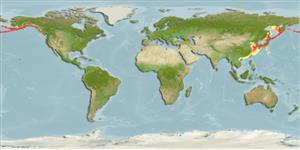Teleostei (teleosts) >
Perciformes/Cottoidei (Sculpins) >
Cottidae (Sculpins)
Etymology: Hemilepidotus: Greek, hemi = half + Greek, lepis = scale + Greek, ous, otis = ear (Ref. 45335).
Eponymy: Dr Charles Henry Gilbert (1859–1928) was an ichthyologist and fishery biologist, whose main area of study was Pacific salmon. [...] (Ref. 128868), visit book page.
More on authors: Jordan & Starks.
Environment: milieu / climate zone / depth range / distribution range
Ecology
Marine; demersal; depth range 0 - 604 m (Ref. 50550). Temperate; 66°N -
North Pacific: Hokkaido, Japan to the Bering Sea.
Length at first maturity / Size / Weight / Age
Maturity: Lm 26.0, range 24 - 28 cm
Max length : 36.0 cm SL male/unsexed; (Ref. 559); common length : 27.0 cm TL male/unsexed; (Ref. 56557); max. published weight: 800.00 g (Ref. 56557); max. reported age: 12 years (Ref. 56557)
Short description
Identification keys | Morphology | Morphometrics
Dorsal spines (total): 11 - 12; Dorsal soft rays (total): 20 - 22; Anal spines: 0; Anal soft rays: 14 - 19. Three zonal scale rows on body; a scale row of small ctenoid scales under the ventral scale row (Ref. 559). Four preopercular spines, the 2nd longest and simple, the 4th flattened; the first dorsal spine longer than the 2nd (Ref. 559).
Oviparous. Non-copulatory. However according to one study, presence of fertilized eggs in the ovary may have resulted from spermatozoa entering the ovary through the ovarian fluid during spawning, and consequently fertilizing unspawned eggs in the ovaries (Ref. 47168). Fertilized eggs in the ovary develop abnormally however, due to the unavailability of needed elements such as oxygen in the ovary (Ref. 47168).
Masuda, H., K. Amaoka, C. Araga, T. Uyeno and T. Yoshino, 1984. The fishes of the Japanese Archipelago. Vol. 1. Tokai University Press, Tokyo, Japan. 437 p. (text). (Ref. 559)
IUCN Red List Status (Ref. 130435: Version 2024-1)
Threat to humans
Harmless
Human uses
Tools
Special reports
Download XML
Internet sources
Estimates based on models
Preferred temperature (Ref.
123201): 0.7 - 14.7, mean 3.9 °C (based on 374 cells).
Phylogenetic diversity index (Ref.
82804): PD
50 = 0.5156 [Uniqueness, from 0.5 = low to 2.0 = high].
Bayesian length-weight: a=0.00589 (0.00281 - 0.01234), b=3.15 (2.97 - 3.33), in cm total length, based on LWR estimates for this (Sub)family-body shape (Ref.
93245).
Trophic level (Ref.
69278): 3.6 ±0.1 se; based on diet studies.
Resilience (Ref.
120179): Low, minimum population doubling time 4.5 - 14 years (tm = 5-6).
Fishing Vulnerability (Ref.
59153): Low to moderate vulnerability (34 of 100).
